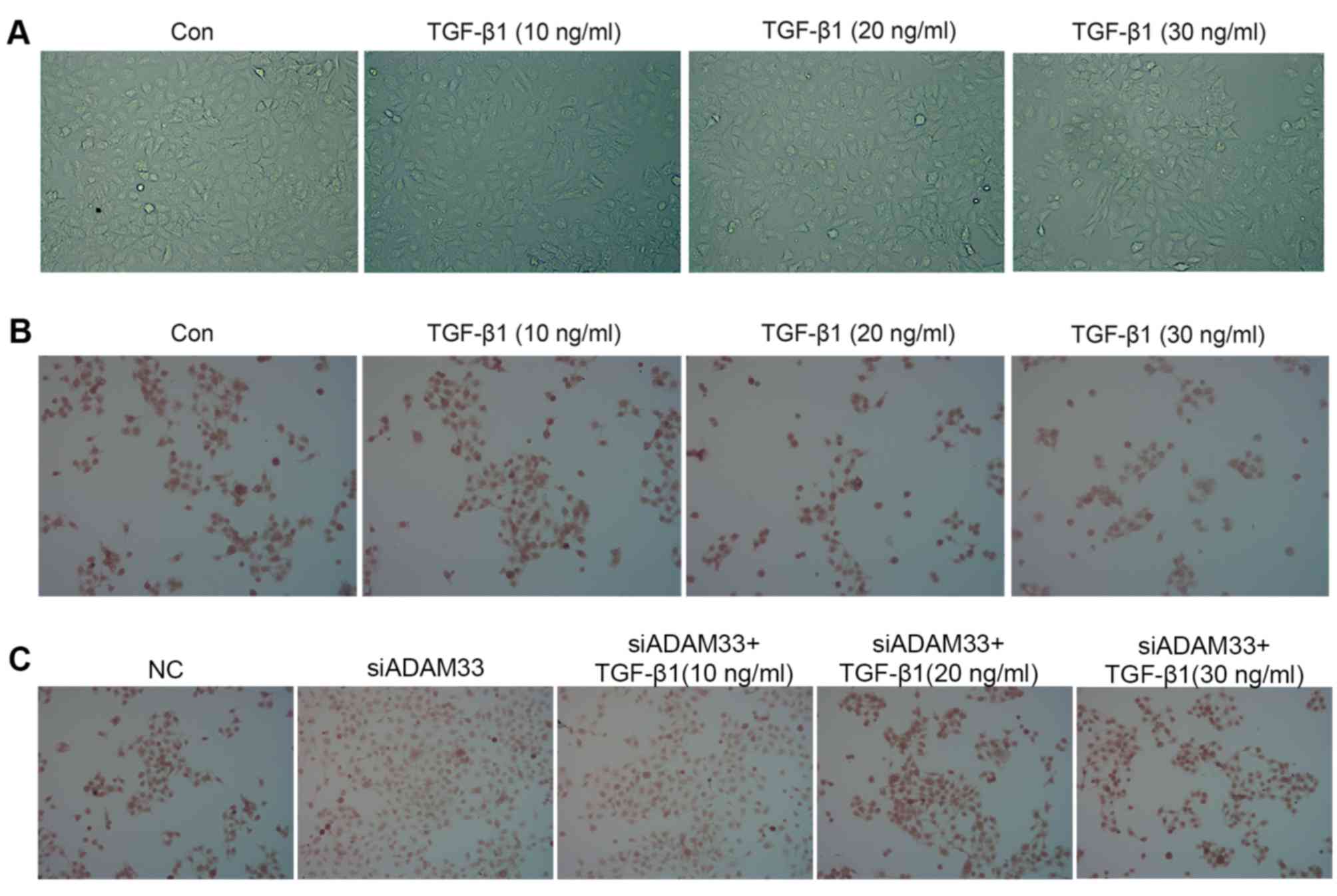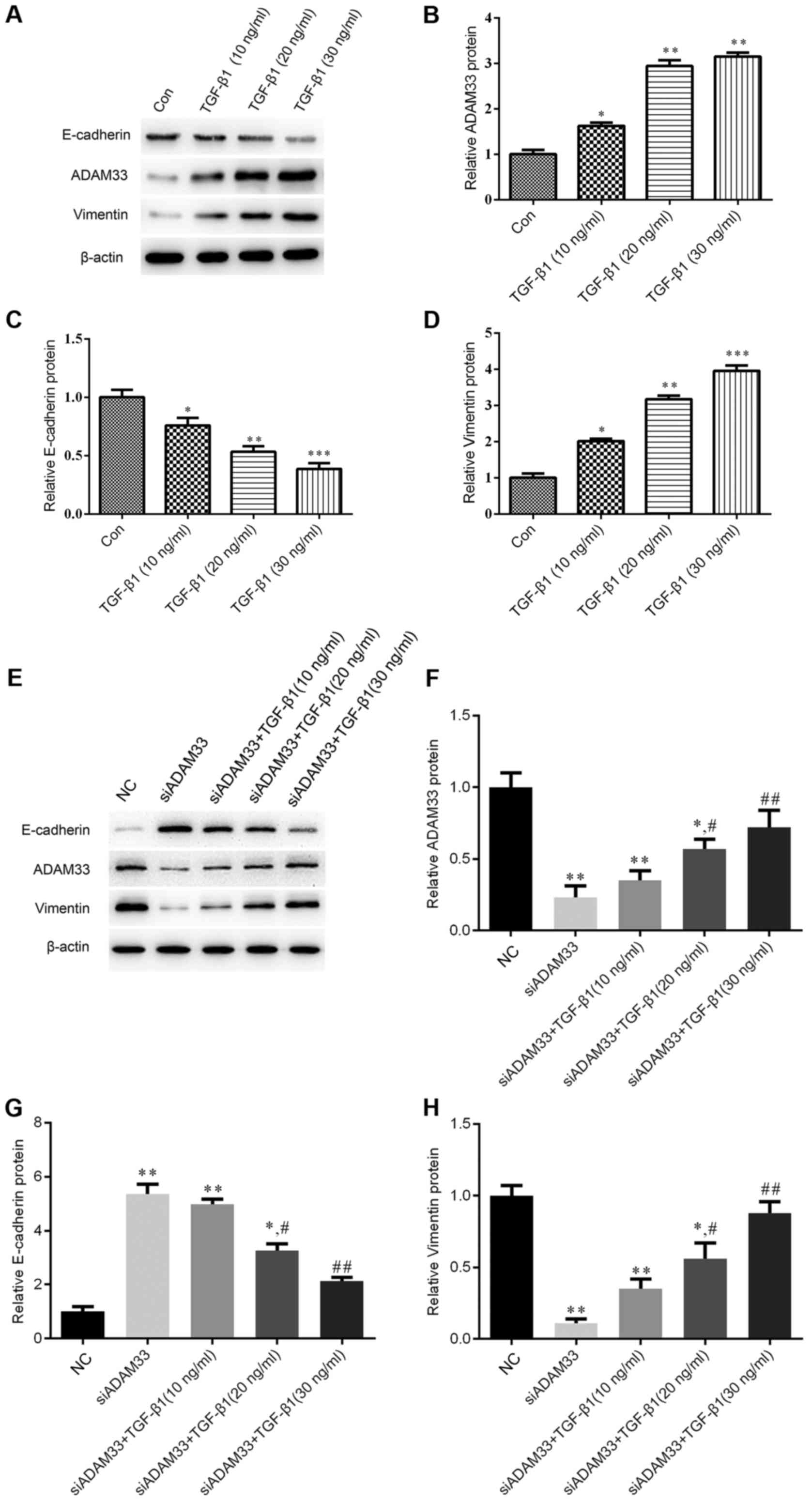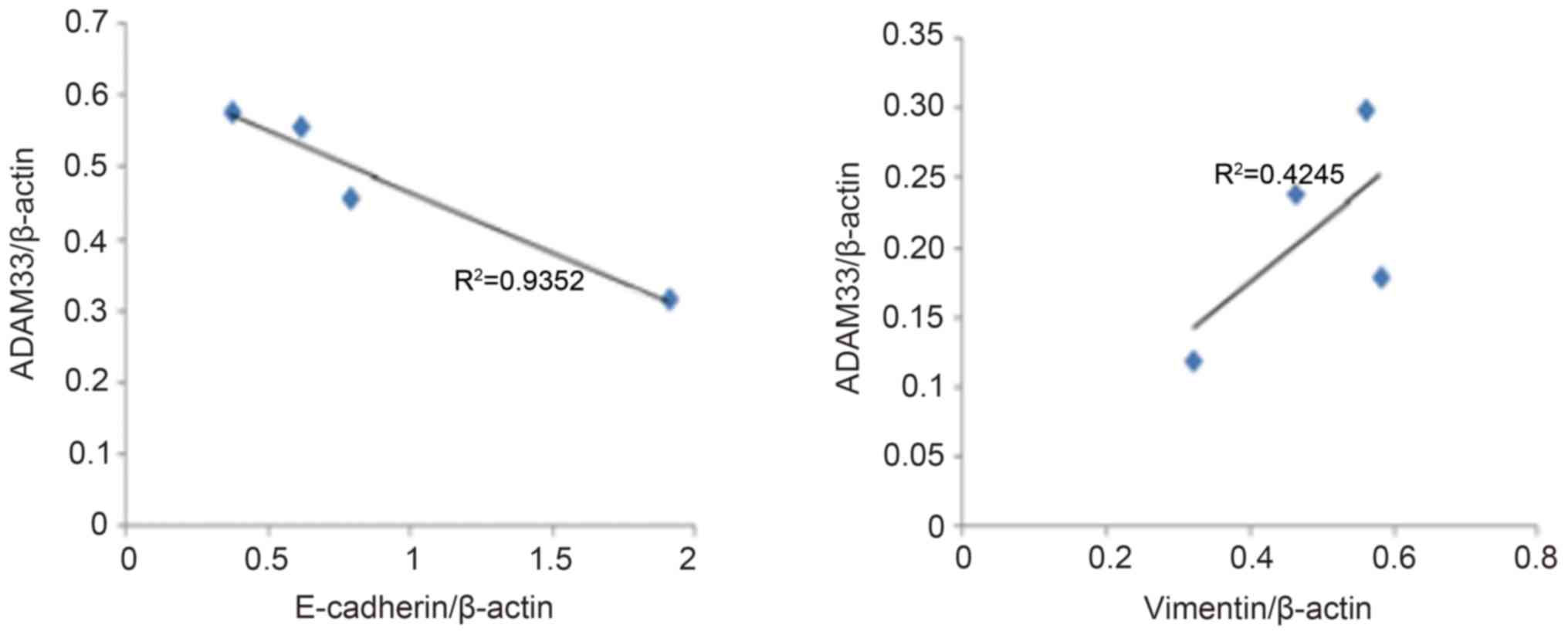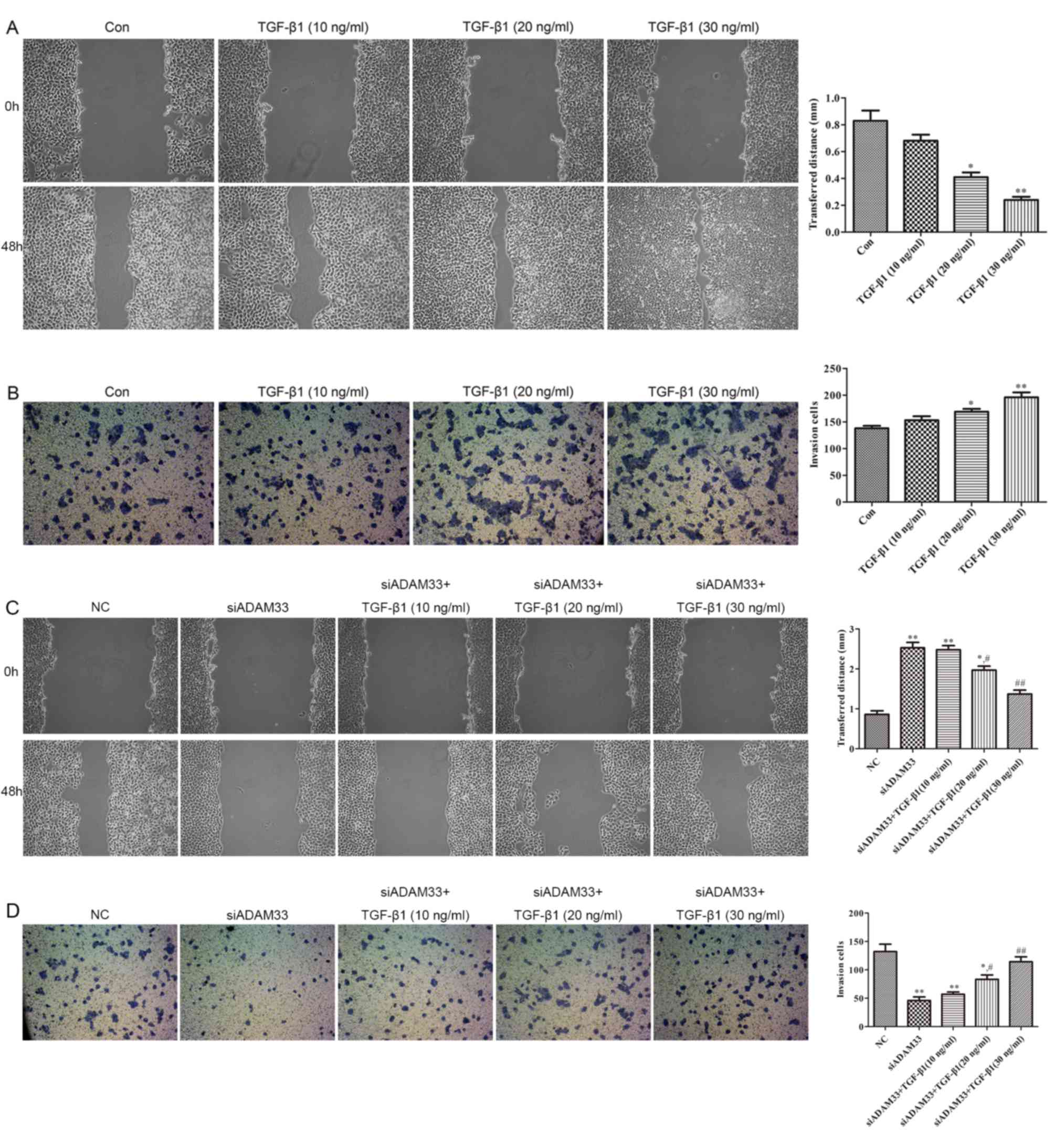TGF-β1 stimulates epithelial‑mesenchymal transition mediated by ADAM33
- Authors:
- Published online on: November 10, 2017 https://doi.org/10.3892/etm.2017.5478
- Pages: 985-992
Abstract
Introduction
Asthma is a heterogeneous disease that is influenced by a variety of factors, which may be hereditary or environmental. Asthma is often accompanied by airway remodeling (AR), which may cause difficulties in controlling the symptoms of asthma and seriously damage human health. The epithelial to mesenchymal transition (EMT) has been indicated to be associated with the process of AR (1–3). Following damage by allergens and other factors, cells may lose their epithelial characteristics, and may undergo morphological changes from regular oval-shaped epithelial cells to irregularly spindle-shaped stromal cells, lose epithelial cell protein markers (such as E-cadherin) and obtain interstitial cell protein markers, including vimentin and α-smooth muscle actin (α-SMA) (4). Transformed epithelial cells participate in the process of AR through cellular activities characteristic of their nascent myofibroblast phenotype (5). In vitro cell experiments have confirmed that EMT-associated changes in airway epithelial cells are mainly regulated by transforming growth factor (TGF)-β1 (6); however, this regulatory process is not only affected by the inflammatory response but also by the expression of a variety of genes in vivo.
Disintegrin and metalloproteinase domain-containing protein 33 (ADAM33), a susceptibility gene for asthma first identified in 2002, is expressed in fibroblasts, smooth muscle cells and other stromal cells in lung tissue, but is not expressed in epithelial cells or T lymphocytes (7). It has been indicated that the expression level of ADAM33 is inversely proportional to the percent forced expiratory volume in 1 sec, a measure that is proportional to the severity of asthma, suggesting that ADAM33 may be involved in the AR process of asthma; however, the underlying mechanism has remained elusive (8). Therefore, the present study aimed to investigate the effects of TGF-β1 on ADAM33 expression in airway epithelial cells, to evaluate the association between ADAM33 expression and TGF-β1-induced EMT, and to further explore the mechanisms of ADAM33 in asthma-induced AR.
Materials and methods
Materials
The normal human bronchial epithelial cell line HBE was purchased from the American Type Culture Collection (Manassas, VA, USA). Dulbecco's modified Eagle's medium (DMEM), fetal calf serum (FCS) and penicillin-streptomycin were from Gibco (Thermo Fisher Scientific, Inc., Waltham, MA, USA). TGF-β1 was purchased from Peprotech Co. (Rocky Hill, NJ, USA). The primary antibodies against E-cadherin (cat. no. sc-71007), vimentin (cat. no. sc-73258), ADAM33 (cat. no. sc-514055) and β-actin (cat. no. sc-47778) and goat anti-mouse IgG-horseradish peroxidase (cat. no. sc-2005), were purchased from Santa Cruz Biotechnology, Inc. (Dallas, TX, USA). TRIzol reagent and the reverse-transcription polymerase chain reaction (RT-PCR) detection kit (cat. no. 11746100) were from Invitrogen (Thermo Fisher Scientific, Inc.).
Cell culture and treatment
HBE cells were cultured in DMEM supplemented with 10% FCS in a humidified atmosphere of 95% air and 5% CO2 in an incubator at 37°C. Cells were passaged when they reached 90% confluence. When third-generation cells reached 80% confluence, the cells were synchronized with high-glucose DMEM containing 1% FCS for 24 h. Subsequently, the cells were treated with various concentrations of TGF-β1 (0, 10, 20 or 30 ng/ml). After treatment for 72 h, the cells were used in the subsequent experiments. Cells were also transfected with small interfering (si)RNA targeting ADAM33 (siADAM33) in the experimental group, or nonsense siRNA (GenScript Biotech Corporation, Nanjing, China) in the negative control (NC) group, using Lipofectamine™ 2000 (Thermo Fisher Scientific, Inc.) following the manufacturer's protocol, and treated with various concentrations of TGF-β1 (0, 10, 20 and 30 ng/ml) for use in the western blot analysis. The sequences of the siRNAs used were as follows: siADAM33 forward, 5′-GGACUCUACCGUUCACCUATT-3′ and reverse, 5′-UAGGUGAACGGUAGAGUCCTT-3′; and nonsense siRNA forward, 5′-UUCUCCGAACGUGUCACGUTT-3′ and reverse, 5′-ACGUGACACGUUCGGAGAATT-3′.
Cell morphology observation
HBE cells were incubated with TGF-β1 for 72 h under standard cell culture conditions. Subsequently, the morphology of the cells was observed under a light microscope (magnification, ×200; Olympus CKX41; Olympus, Tokyo, Japan).
Immunohistochemistry
HBE cells on coverslips were fixed with 4% paraformaldehyde for 15 min and permeabilized with 0.5% Triton X-100 for 20 min, prior to incubation with 3% H2O2 for 15 min and blocking in bovine serum albumin (Biosharp, Hefei, China). The cells were then incubated with the primary antibody against E-cadherin (sc-71007; 1:500 dilution; Santa Cruz Biotechnology, Inc.) at room temperature for 1 h, followed by detection with biotin-labeled secondary antibodies (cat. no. sc-2040; 1:2,000; Santa Cruz Biotechnology, Inc.) at room temperature for 30 min and a streptavidin biotin complex kit (cat. no. GTX30965; GeneTex, Inc., Irvine, CA, USA) at 37°C for 20 min. The coverslips were developed with diaminobenzidine for 15 min and counterstained with 1% hematoxylin at room temperature for 1 min. Finally, coverslips were mounted and observed under a microscope.
Western blot analysis
After treatment for 72 h, total protein from the cells was collected with radioimmunoprecipitation assay buffer. A bicinchoninic acid assay was performed to detect the protein concentration in the cell lysates. Protein samples (30 µg/lane) were separated by 10% SDS-PAGE and then transferred onto a polyvinylidene difluoride membrane (Merck KGaA, Darmstadt, Germany), which was blocked with 5% bovine serum albumin for 2 h at room temperature. Membranes were incubated with the primary antibodies (1:1,000 dilution) overnight at 4°C, washed three times with Tris-buffered saline containing Tween 20 and then incubated with horseradish peroxidase-conjugated secondary antibodies (1:2,000 dilution) for 2 h at room temperature. The membranes were developed with an enhanced chemiluminescence kit (cat. no. P0018; Beyotime Institute of Biotechnology, Haimen, China) according to the manufacturer's protocol. The Tanon-5200 (Tanon Science and Technology Co., Ltd., Shanghai, China) automatic chemiluminescence image analysis system was used for gray scale scanning and quantitative analysis. β-actin was used as the internal control.
RT-qPCR analysis
Total RNA was isolated with TRIzol regent according to the manufacturer's instructions. Complementary (c)DNA was generated using the RT-PCR detection kit following the manufacturer's protocol, and real-time PCR was then performed to amplify the synthesized cDNA using the SYBR Green qPCR Mix (Beyotime Institute of Biotechnology) following the manufacturer's protocol. GAPDH was used as the internal control. The amplification conditions were as follows: Initial activation at 95°C for 5 min, followed by 40 amplification cycles of denaturation at 95°C for 30 sec, annealing at 56°C for 45 sec and extension at 72°C for 30 sec. The primer sequences used in the real-time PCR analysis are listed in Table I. The expression levels of the target genes were analyzed using the 2−ΔΔCq method (9).
Wound healing assay
HBE cells were seeded in 6-well plates at a density of 5×104/well and cultured for 24 h, after which a straight scratch wound was made across the cell monolayer using a 200-µl pipette tip. Wells were washed with PBS and serum-free DMEM was applied to the cells. Images were captured after 48 h.
Cell invasion assay
The invasion potential of HBE cells was assessed using a Transwell assay. The Transwell inserts (Corning Incorporated, Corning, NY, USA) were pre-coated with Matrigel. Cells (5×104) in serum-free medium were seeded into the upper chamber, while medium containing 10% FBS was added to the lower chamber. After incubation for 48 h at 37°C, cells that had invaded to the lower chamber were stained with crystal violet at room temperature for 30 min and observed under a microscope.
Statistical analysis
SPSS 16.0 statistical software (SPSS, Inc., Chicago, IL, USA) was used for all statistical analyses. Values are expressed as the mean ± standard deviation and a Shapiro-Wilk normal distribution test and a Levene variance homogeneity test were performed. Analysis of variance was used for comparisons between multiple groups. A Student Newman Keuls t-test was used to compare the differences between two groups. Pearson's linear correlation analysis was used to analyze different indexes. P<0.05 was considered to indicate a statistically significant difference.
Results
Effect of TGF-β1 on HBE cell morphology
Following stimulation with different concentrations of TGF-β1, HBE cell morphology exhibited changes characteristic for EMT: Cell clusters were scattered with increased numbers of free cells, and cells exhibited a spindle-shaped, fibroblast-like morphology. With increasing TGF-β1 concentration, the cell morphology changes became more obvious, such that the percentage of cells exhibiting the fibroblast-like form was highest when the TGF-β1 concentration was 30 ng/ml. By contrast, the cells in the control group still displayed an oval-shaped, epithelial morphology (Fig. 1A).
Effect of TGF-β1 on the protein expression of ADAM33, E-cadherin and vimentin in HBE cells
Immunohistochemical analysis indicated that TGF-β1 inhibited E-cadherin protein expression in a dose-dependent manner (Fig. 1B) and siADAM33 relieved this inhibition (Fig. 1C). Following treatment with various concentrations of TGF-β1 (10, 20 or 30 ng/ml), the protein expression levels of ADAM33 were significantly increased in the HBE cells, which suggested that TGF-β1 promoted the expression of ADAM33 in HBE cells (Fig. 2A and B). In addition, TGF-β1 inhibited E-cadherin protein expression in a dose-dependent manner (Fig. 2A and C), whereas the protein expression of vimentin was significantly increased in HBE cells after stimulation with various concentrations of TGF-β1 (Fig. 2A and D).
After transfection of siADAM33 into HBE cells, the protein expression levels of ADAM33 were significantly decreased compared with the NC group (Fig. 2E and F). As presented in Fig. 2E, G and H, siADAM33 promoted the expression of E-cadherin and repressed the expression of vimentin compared with the siADAM33 group. These results indicated that the stimulation of the EMT process by TGF-β1 may be mediated by ADAM33.
Effect of TGF-β1 on the mRNA expression of ADAM33, E-cadherin and vimentin in HBE cells
As presented in Fig. 3, compared with the control group, the mRNA expression levels of ADAM33 and vimentin were significantly increased in HBE cells treated with various concentrations of TGF-β1 (10, 20 or 30 ng/ml). Furthermore, TGF-β1 significantly inhibited E-cadherin mRNA expression in a dose-dependent manner.
Correlation analysis of ADAM33 expression with E-cadherin and vimentin expression
As presented in Fig. 4, the results of the correlation analysis indicated a significant negative correlation between ADAM33 protein expression and E-cadherin expression (R2=0.935, P<0.05), whereas there was a positive correlation between ADAM33 and vimentin expression (R2=0.425, P<0.05).
Effect of TGF-β1 on the migration and invasion of HBE cells
As illustrated in Fig. 5A, compared with the control group, wound healing was promoted by TGF-β1 in a dose-dependent manner (10, 20 and 30 ng/ml). Furthermore, the results of the cell invasion assay indicated that the invasive ability of HBE cells was increased by TGF-β1 in a dose-dependent manner (10, 20 and 30 ng/ml; Fig. 5B). Following transfection of siADAM33 into HBE cells, wound healing and invasive ability were observed to be inhibited by siADAM33 compared with the NC group (Fig. 5C and D). These results indicate that the migration and invasion of HBE cells induced by TGF-β1 may be mediated by ADAM33.
Discussion
The human ADAM33 gene, which is located on the short arm of chromosome 20 (20p13), is one of the most significant susceptibility genes in asthma. The full-length ADAM33 gene is ~2,439 bp, comprising 22 exons and 21 introns, and is divided into eight domains: A signal peptide domain, a prodomain, a metalloproteinase domain, a disintegrin domain, a cysteine-containing domain, an epidermal growth factor domain, a transmembrane domain and a cytoplasmic domain. The metalloproteinase domain comprises a zinc finger structure sequence that encodes a protein with enzymatic activity responsible for cleaving peptides bound to proteins, and thereby exhibits proteolytic enzyme action. The presence of the growth factor domain suggests that ADAM33 may be associated with cell proliferation and differentiation (7). Due to ADAM33 expression and its molecular structure, as well as functional characteristics in mesenchymal cells and epithelial cells in human lung tissue, it is thought that ADAM33 may be involved in the process of AR in chronic inflammatory airway disease, including asthma and chronic obstructive pulmonary disease (10,11).
A previous study revealed that the expression levels of ADAM33 were upregulated in the lung tissues of asthma patients (12). In another study, in situ hybridization and immunohistochemistry were used to determine the mRNA and protein expression levels of ADAM33 in human bronchial biopsy specimens, and the results indicated that ADAM33 was significantly overexpressed in tissues from asthmatic patients compared with those from normal subjects (13). In addition, the expression levels of ADAM33 in human fibroblasts cultured in vitro were reported to be upregulated by interleukin-4 and −13 stimulation (14) and the same result was obtained in smooth muscle cells cultured in vitro, but not in cultured epithelial cells, endothelial cells or neutrophils (15). These studies suggested that the immune imbalance of T helper type I vs. type II cells in asthma may contribute to the expression of ADAM33 in interstitial cells. Foley et al (16) reported that the expression levels of ADAM33 in patients with severe and moderate asthma were significantly higher than those in patients with mild or controlled asthma, and that it was also significantly increased in epithelial, submucosal and smooth muscle cells. In summary, these studies indicated that ADAM33 expression was upregulated in airway epithelial and stromal cells, and that there were significant differences in ADAM33 expression according to the severity of asthma, suggesting that ADAM33 may be involved in the AR process.
The nature of the participation of ADAM33 in AR, and its associated mechanisms, have remained elusive. A previous study using a mouse model of asthma demonstrated that the expression levels of ADAM33 in airway smooth muscle cells were positively correlated with cytoskeletal protein proliferation, suggesting that ADAM33 may promote asthma-associated AR by promoting smooth muscle cell proliferation (17). In addition, in tissue culture, it was demonstrated that ADAM33 was involved in the AR process though interacting with α-actin and other interstitial cell proteins (18). Furthermore, another study indicated that ADAM33 was activated and overexpressed in response to TGF-β2 stimulation in primary cultured airway fibroblasts (PBF), suggesting that ADAM33 participates in asthma AR by promoting PBF activation (19).
Epithelial cells are the primary barrier against harmful environmental stimuli, including pollutants, harmful gases, allergens and pathogenic microorganisms. The process of injury-repair-reinjury of epithelial cells is the primary step in AR, and EMT is involved and has important roles in this process. It has been confirmed that epithelial cells participate in AR-associated processes, such as subepithelial fibrosis, by undergoing EMT to transform into mesenchymal cells and subsequently serving the role of fibroblasts. TGF-β1 is the only cytokine that has been demonstrated to independently induce EMT in airway epithelial cells (2,20–22). As a member of the growth factor family, TGF-β1 has a binding site specific for ADAM33. However, whether TGF-β1 has an effect on ADAM33 expression in airway epithelial cells, as well as the association between ADAM33 expression and TGF-β1-induced EMT, have remained elusive. In the present study, HBE cells were stimulated with TGF-β1 to observe its effect on ADAM33 expression, cell migration and invasion in airway epithelial cells, and the association between ADAM33 expression and TGF-β1-induced EMT-associated proteins, including E-cadherin, vimentin and α-SMA, was investigated. The results suggested that stimulation of HBE cells with various concentrations of TGF-β1 enhanced ADAM33 expression, indicating that TGF-β1 promoted the expression of ADAM33 in airway epithelial cells in vitro. The results of a correlation analysis revealed that TGF-β1 promoted the expression of ADAM33, which was negatively correlated with E-cadherin and positively correlated with vimentin, suggesting that the TGF-β1-induced upregulation of ADAM33 is closely associated with the EMT process induced by TGF-β1, and that it is particularly strongly associated with the decrease of E-cadherin. In a loss-of-function experiment, ADAM33 was knocked down in order to further clarify the association between ADAM33 expression and EMT-associated proteins in airway epithelial cells stimulated by TGF-β1. The results of a western blot analysis indicated that siADAM33 promoted the expression of E-cadherin and repressed the expression of vimentin, and that TGF-β1 suppressed these changes. These results confirmed that the stimulation of the EMT process by TGF-β1 may be mediated via ADAM33.
Acknowledgements
The present study was supported by Jinling Hospital (grant no. 2015062).
References
|
Heijink IH, Postma DS, Noordhoek JA, Broekema M and Kapus A: House dust mite-promoted epithelial-to-mesenchymal transition in human bronchial epithelium. Am J Respir Cell Mol Biol. 42:69–79. 2010. View Article : Google Scholar : PubMed/NCBI | |
|
Hackett TL, Warner SM, Stefanowicz D, Shaheen F, Pechkovsky DV, Murray LA, Argentieri R, Kicic A, Stick SM, Bai TR and Knight DA: Induction of epithelial-mesenchymal transition in primary airway epithelial cells from patients with asthma by transforming growth factor-beta1. Am J Respir Crit Care Med. 180:122–133. 2009. View Article : Google Scholar : PubMed/NCBI | |
|
Hackett TL: Epithelial-mesenchymal transition in the pathophysiology of airway remodelling in asthma. Curr Opin Allergy Clin Immunol. 12:53–59. 2012. View Article : Google Scholar : PubMed/NCBI | |
|
Johnson JR, Roos A, Berg T, Nord M and Fuxe J: Chronic respiratory aeroallergen exposure in mice induces epithelial-mesenchymal transition in the large airway. PLoS One. 6:e161752011. View Article : Google Scholar : PubMed/NCBI | |
|
Wang JH, Sun LH, Huang SK and Chen AH: Effect of co-culturing human primary basic fibroblasts with respiratory syncytial virus-infected 16-HBE cells. Genet Mol Res. 15:150173392016. | |
|
Ko H, So Y, Jeon H, Jeong MH, Choi HK, Ryu SH, Lee SW, Yoon HG and Choi KC: TGF-β1-induced epithelial-mesenchymal transition and acetylation of Smad2 and Smad3 are negatively regulated by EGCG in human A549 lung cancer cells. Cancer Lett. 335:205–213. 2013. View Article : Google Scholar : PubMed/NCBI | |
|
Van Eerdewegh P, Little RD, Dupuis J, Del Mastro RG, Falls K, Simon J, Torrey D, Pandit S, McKenny J, Braunschweiger K, et al: Association of the ADAM33 gene with asthma and bronchial hyperresponsiveness. Nature. 418:426–430. 2002. View Article : Google Scholar : PubMed/NCBI | |
|
Lee JY, Park SW, Chang HK, Kim HY, Rhim T, Lee JH, Jang AS, Koh ES and Park CS: A disintegrin and metalloproteinase 33 protein in patients with asthma: Relevance to airflow limitation. Am J Respir Crit Care Med. 173:729–735. 2006. View Article : Google Scholar : PubMed/NCBI | |
|
Livak KJ and Schmittgen TD: Analysis of relative gene expression data using real-time quantitative PCR and the 2(-Delta Delta C(T)) method. Methods. 25:402–408. 2001. View Article : Google Scholar : PubMed/NCBI | |
|
Holgate ST: ADAM metallopeptidase domain 33 (ADAM33): Identification and role in airways disease. Drug News Perspect. 23:381–387. 2010.PubMed/NCBI | |
|
Xiao J, Han J, Wang X, Hua D, Su D, Bao Y and Lv F: Association of ADAM33 gene with susceptibility to COPD in Tibetan population of China. Mol Biol Rep. 38:4941–4945. 2011. View Article : Google Scholar : PubMed/NCBI | |
|
Sunadome H, Matsumoto H, Petrova G, Kanemitsu Y, Tohda Y, Horiguchi T, Kita H, Kuwabara K, Tomii K, Otsuka K, et al: IL4Rα and ADAM33 as genetic markers in asthma exacerbations and type-2 inflammatory endotype. Clin Exp Allergy. 47:998–1006. 2017. View Article : Google Scholar : PubMed/NCBI | |
|
Ito I, Laporte JD, Fiset PO, Asai K, Yamauchi Y, Martin JG and Hamid Q: Downregulation of a disintegrin and metalloproteinase 33 by IFN-gamma in human airway smooth muscle cells. J Allergy Clin Immunol. 119:89–97. 2007. View Article : Google Scholar : PubMed/NCBI | |
|
Jie Z, Jin M, Cai Y, Bai C, Shen Y, Yuan Z, Hu Y and Holgate S: The effects of Th2 cytokines on the expression of ADAM33 in allergen-induced chronic airway inflammation. Respir Physiol Neurobiol. 168:289–294. 2009. View Article : Google Scholar : PubMed/NCBI | |
|
Tripathi P, Awasthi S, Husain N, Prasad R and Mishra V: Increased expression of ADAM33 protein in asthmatic patients as compared to non-asthmatic controls. Indian J Med Res. 137:507–514. 2013.PubMed/NCBI | |
|
Foley SC, Mogas AK, Olivenstein R, Fiset PO, Chakir J, Bourbeau J, Ernst P, Lemière C, Martin JG and Hamid Q: Increased expression of ADAM33 and ADAM8 with disease progression in asthma. J Allergy Clin Immunol. 119:863–871. 2007. View Article : Google Scholar : PubMed/NCBI | |
|
Lin F, Song A, Wu J, Jiang X, Long J, Chen J, Duan Y, Shi Y and Deng L: ADAM33 protein expression and the mechanics of airway smooth muscle cells and highly correlated in ovalbumin-sensitized rats. Mol Med Rep. 8:1209–1215. 2013. View Article : Google Scholar : PubMed/NCBI | |
|
Haitchi HM, Powell RM, Shaw TJ, Howarth PH, Wilson SJ, Wilson DI, Holgate ST and Davies DE: ADAM33 expression in asthmatic airways and humanembryonic lungs. Am J Respir Crit Care Med. 171:958–965. 2005. View Article : Google Scholar : PubMed/NCBI | |
|
Yang Y, Wicks J, Haitchi HM, Powell RM, Manuyakorn W, Howarth PH, Holgate ST and Davies DE: Regulation of a disintegrin and metalloprotease-33 expression by transforming growth factor-β. Am J Respir Cell Mol Biol. 46:633–640. 2012. View Article : Google Scholar : PubMed/NCBI | |
|
Zhang M, Zhang Z, Pan HY, Wang DX, Deng ZT and Ye XL: TGF-beta1 induces human bronchial epithelial cell-to-mesenchymal transition in vitro. Lung. 187:187–194. 2009. View Article : Google Scholar : PubMed/NCBI | |
|
Kamitani S, Yamauchi Y, Kawasaki S, Takami K, Takizawa H, Nagase T and Kohyama T: Simultaneous stimulation with TGF-β1 and TNF-α induces epithelial mesenchymal transition in bronchial epithelial cells. Int Arch Allergy Immunol. 155:119–128. 2011. View Article : Google Scholar : PubMed/NCBI | |
|
Yang ZC, Yi MJ, Ran N, Wang C, Fu P, Feng XY, Xu L and Qu ZH: Transforming growth factor-β1 induces bronchial epithelial cells to mesenchymal transition by activating the Snail pathway and promotes airway remodeling in asthma. Mol Med Rep. 8:1663–1668. 2013. View Article : Google Scholar : PubMed/NCBI |














